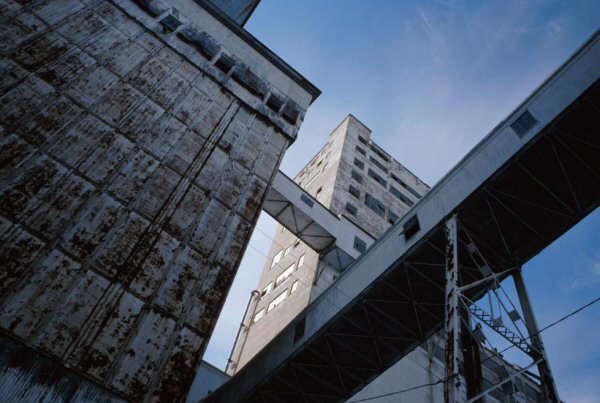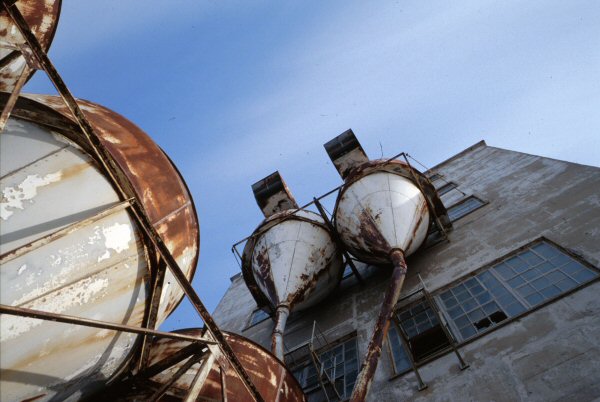Please wait a few moments while we process your request

Quartier Éphémère
Silophone
[The User] initiated the Silophone project in co-operation with Quartier Éphémère. QE was born out of a relationship with the French organization Usines Éphémères, an artist-run association that temporarily occupies abandoned buildings and offers the newly renovated spaces up for artistic use. Quartier Éphémère has occupied three abandoned spaces in Montreal since its formation in 1993. The Silophone was another example of this sort of renovation and remained in the public eye from June 9, 2000, to June 17, 2001.
The silo itself, the central part of which was built in 1906, had a distinct reputation before the artists' intervention. It was cited by Le Corbusier as an example of the architecture of the future and remains an impressive monument. In conjunction with the transformation of the silo into a sonic instrument, Heritage Montreal and the Association québécoise pour le patrimoine industriel gave guided tours of the silos in the area and organized a historical exhibition dedicated to Silo No. 5 at the Centre d'histoire de Montréal.
[The User]'s main inspiration for the silo project is the extraordinary range of acoustics within the abandoned space. According to the group's press release, the reverberation time is over 20 seconds. (1) Sounds injected into the silo are stretched out, dragged sensually through the structure and transformed into ethereal sonic landscapes. To capitalize on this amazing potential for sound, [The User] has placed an elaborate system of microphones into the silo. Thanks to new communication technologies, anyone around the world could access the Silophone through a toll-free number and the Internet. (2) Sound files from the Internet or random, even banal murmurs or cries could be injected through the telephone. Once the sound entered the silo, it resonated inside the space and then was rebroadcast back to the person who "played" the instrument and anyone who had tuned in to listen or was passing by the sound installation set up outside the silo.
Throughout the one-year installation period, [The User] and several international organizations commissioned sound artists to composed works for the Silophone. The participating organizations were ACREQ, (Montreal, Canada), Le Navire Night (Montreal, Canada), Staalplaat (Amsterdam et Berlin), and The Wire (London, England). [The User] performed several more concerts of pieces composed for the instrument.
In June 2000, they presented a first performance of the Silophone in front of a large and critical crowd. The performance had been much hyped, but because of technical difficulties, it did not go over well. [The User] started the show an hour late and the actual performance lasted only a few minutes. Reactions from the local press were mostly critical (3). Several concerts are slated for the Silophone over the course of its one year installation period. On-line events took place in August 2000 in collaboration with Anna Friz from Vancouver an Video Pool in Winnipeg. A successful live performance of pieces composed for the Silophone was presented in the context of ELEKTRA, a festival of electroacoustic music organized by l'ACREQ, in Montréal in September 2000. On October 7, 2000, Francisco Lopez (Spain), Martin Tétreault (Canada) and I8U (Canada) performed at the Quartier Éphémère's current home, the Darling Foundry, in a concert co-produced by Montreal's Alien8 Records. Finally, in collaboration with Le Navire Night, the Silophone 's closing event took place on June 17, 2001 with performance by Carsten Nicolai (Germany), Aube (Japan), Steve Heimbecker (Canada), Jean-François Laporte (Canada), and [The User].
The silo itself, the central part of which was built in 1906, had a distinct reputation before the artists' intervention. It was cited by Le Corbusier as an example of the architecture of the future and remains an impressive monument. In conjunction with the transformation of the silo into a sonic instrument, Heritage Montreal and the Association québécoise pour le patrimoine industriel gave guided tours of the silos in the area and organized a historical exhibition dedicated to Silo No. 5 at the Centre d'histoire de Montréal.
[The User]'s main inspiration for the silo project is the extraordinary range of acoustics within the abandoned space. According to the group's press release, the reverberation time is over 20 seconds. (1) Sounds injected into the silo are stretched out, dragged sensually through the structure and transformed into ethereal sonic landscapes. To capitalize on this amazing potential for sound, [The User] has placed an elaborate system of microphones into the silo. Thanks to new communication technologies, anyone around the world could access the Silophone through a toll-free number and the Internet. (2) Sound files from the Internet or random, even banal murmurs or cries could be injected through the telephone. Once the sound entered the silo, it resonated inside the space and then was rebroadcast back to the person who "played" the instrument and anyone who had tuned in to listen or was passing by the sound installation set up outside the silo.
Throughout the one-year installation period, [The User] and several international organizations commissioned sound artists to composed works for the Silophone. The participating organizations were ACREQ, (Montreal, Canada), Le Navire Night (Montreal, Canada), Staalplaat (Amsterdam et Berlin), and The Wire (London, England). [The User] performed several more concerts of pieces composed for the instrument.
In June 2000, they presented a first performance of the Silophone in front of a large and critical crowd. The performance had been much hyped, but because of technical difficulties, it did not go over well. [The User] started the show an hour late and the actual performance lasted only a few minutes. Reactions from the local press were mostly critical (3). Several concerts are slated for the Silophone over the course of its one year installation period. On-line events took place in August 2000 in collaboration with Anna Friz from Vancouver an Video Pool in Winnipeg. A successful live performance of pieces composed for the Silophone was presented in the context of ELEKTRA, a festival of electroacoustic music organized by l'ACREQ, in Montréal in September 2000. On October 7, 2000, Francisco Lopez (Spain), Martin Tétreault (Canada) and I8U (Canada) performed at the Quartier Éphémère's current home, the Darling Foundry, in a concert co-produced by Montreal's Alien8 Records. Finally, in collaboration with Le Navire Night, the Silophone 's closing event took place on June 17, 2001 with performance by Carsten Nicolai (Germany), Aube (Japan), Steve Heimbecker (Canada), Jean-François Laporte (Canada), and [The User].
Angela Plohman © 2004 FDL
(1) See the Silophone press release in the CR&D artist file.
(2) Silophone : http://www.silophone.net/
(3) See Basem Boshra, "The sounds of silo?: concert echoes out of grain elevator at Old Port," The Gazette (June 10, 2000): A3; David Theodore, "Silo's song is a little of key : idea of turning grain elevator into musical instrument is better in concept than in practice," The Gazette (June 10, 2000): J6; Suzanne Colpron, "Même Gaston Lagaffe en resterait baba : le silo n°5 devient un gigantesque instrument de musique planétaire," La Presse (June 10, 2000): D18; François Tousignant, "La charrue avant les boeufs," Le Devoir (June 12, 2000): B8.
Related pages:
 Quartier Éphémère
Quartier ÉphémèreOfficially formed in 1993, Quartier Éphémère (QE) is an ephemeral arts organisation.
![[The User] [The User]](../inc/corners/cropCorners.php?src=media/projets/1061-5-2002/user-s.jpg&radius=10&width=87&height=53) [The User]
[The User]Formed in 1997, [The User] is an artists' collective made up of the architect Thomas McIntosh and the composer Emmanuel Madan.
External links:
Silophone :
http://www.silophone.net
http://www.silophone.net
Le Navire Night : Silophone :
http://www.radio-canada.ca/radio/navire/em...
http://www.radio-canada.ca/radio/navire/em...
[The User]:
http://www.theuser.org
http://www.theuser.org
Quartier Éphémère:
http://www.quartierephemere.org
http://www.quartierephemere.org









